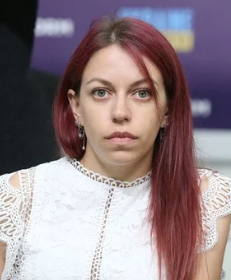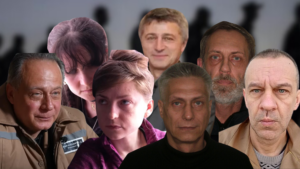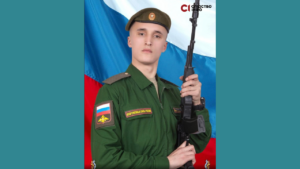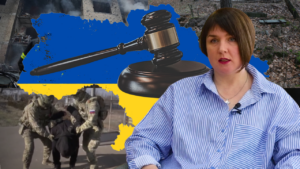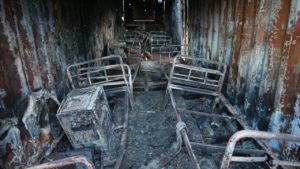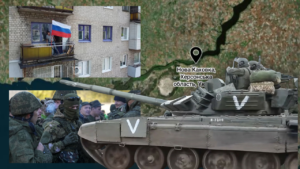Genocide in Srebrenica: History Lessons for Ukraine
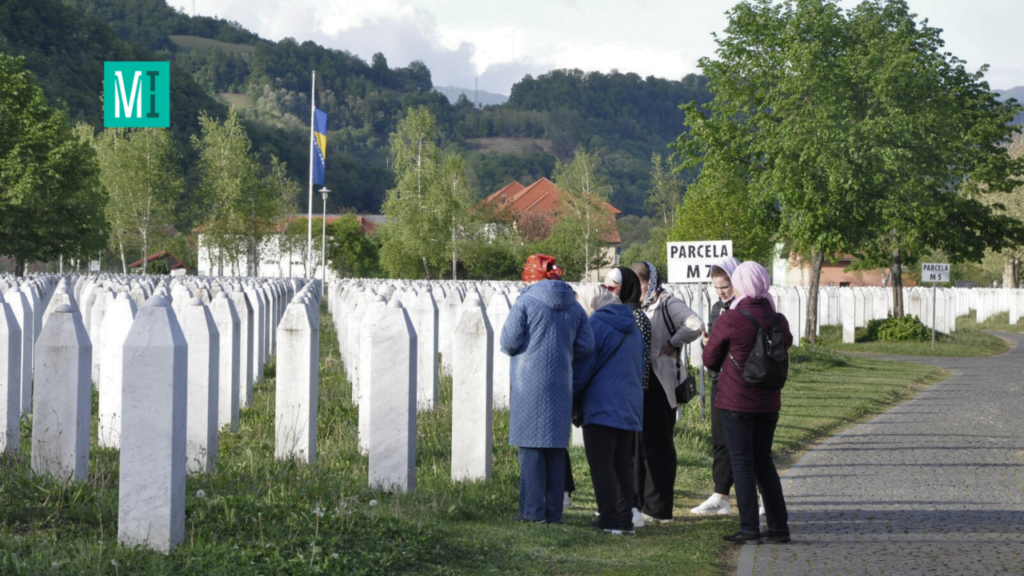
On 11 July 1995, over eight thousand Bosnian Muslims — men and boys — were captured and killed by the forces and police of Bosnian Serbs near the town of Srebrenica. The planned and organized massacre of people on religious and ethnic grounds is still considered the largest in Europe since World War II.
“When you find yourself in the cemetery in Srebrenica and see the number of graves that go beyond the horizon, you realize the scale of the tragedy when thousands of people were shot dead in a matter of days. When you listen to stories about the search for the living, and then the bodies of the dead, it feels horrifying because all of this is happening now in Ukraine,” Olena Bieliachkova, coordinator of the MIHR’s groups of families of captives, shares her impressions.
Bieliachkova visited the Memorial Center in Srebrenica as part of an educational trip to Bosnia and Herzegovina organized by the International Commission on Missing Persons (ICMP).
Firsthand: in every Muslim family, they killed 20-40 men
The local guide, who survived the Srebrenica genocide as a young boy, recalls how on 11 July 1995, after the Bosnian Serb army overcame the resistance of Bosnian Muslim forces and entered Srebrenica, the Serbs persuaded the Dutch peacekeepers, whose unit was stationed in the neighboring village of Potočari on the premises of a local factory, to hand over men aged 14 to 80 who were hiding at the base. In total, about 300 people. That was the last time women and children saw their husbands and sons.
The war in Bosnia and Herzegovina started in the spring of 1992 after a referendum on independence from Yugoslavia. At that time, 99% of those who voted supported independence, mainly Bosniak Muslims, who accounted for 43% of the republic’s population, and Catholic Croats, who constituted 17%. The remaining 31%, mostly Orthodox Serbs, boycotted the vote.
The predominantly Muslim Sarajevo found itself under a several-year siege by the Bosnian Serb army. Combat operations took place in the territories of other Bosnian enclaves centered in the towns of Srebrenica, Žepa, and Gorazde. For several years, the Serbs attempted to seize these territories. Later, the UN deployed their peacekeepers in some of them and declared safe zones. Near Srebrenica, there was a contingent of UN peacekeepers from the Netherlands.
What happened after 11 July 1995, they found out later. Bosnian Serb forces, along with the Scorpions paramilitary unit operating under the control of the Serbian Interior Ministry, captured several thousand Bosnian Muslims. They were held separately, taken away in groups, and then executed in remote locations. The executions were filmed. Those who survived were forced to drag away the bodies, and then they were killed as well. The dead were buried in mass graves.

A monument in honor of Bosnian Muslims who perished during the 1995 massacre in Srebrenica
In total, within several days, the military forces of the Bosnian Serbs killed over eight thousand Bosnian Muslims. Many of them were considered missing for a long time. This is what the women of the Association ‘Movement of Mothers of the Srebrenica and Žepa Enclaves’, which has existed since the 1990s, share about in Srebrenica. When their husbands were taken away, they hoped that they would survive the captivity. But the horrifying news of massacres shattered their belief: in those days, in almost every large Muslim family, 20-40 men perished. After the end of hostilities, women began to fight for the truth and search for the bodies of their relatives.
From acceptance to action: collecting testimonies and evidence
Munira Subašić, the head of the ‘Movement of Mothers of the Srebrenica and Žepa Enclaves’, lost her youngest son, husband, and 20 other family members at that time.
“But we didn’t sit and cry for long. We took to the streets and did important work: we tried in every way to draw the world’s attention to the genocide that took place in Srebrenica. We demanded evidence of the killing of men and asked where their bodies were. Because we didn’t believe they were all dead.”
When most of the mass burial sites were found, the ICMP helped to identify the remains of the executed men. They also joined in the burial process.
“We saw how the experts worked and learned from them. We realized that no one but ourselves could learn like that. We never thought we would have to deal with something like that. But life is unpredictable,” Subašić explains.
Eventually, the mothers registered an organization at the Ministry of Justice of Bosnia and Herzegovina to fight for the families’ rights more effectively.
“We started compiling lists of potential members of the organization and the lists of missing people we learned about through the association. The women cooperated with the investigation: they collected testimonies from victims of the crimes in Srebrenica and provided information to the Prosecutor’s office and the court,” she adds.
The Family Association cooperated with the investigators and prosecutors of the International Criminal Tribunal for the former Yugoslavia, established on 25 May 1993 by a UN Security Council resolution.
“We collected and sent everything. There was no insignificant information for us; everything was important. Anything that indicated victims, witnesses, and perpetrators,” Munira Subašić notes. “We sent letters to everyone: to those who were guilty and other parties of the conflict, as well as to esteemed European institutions and the UN Security Council. There were many questions and few answers.”
The human rights activist is convinced that today, Ukrainian women and families of missing persons should follow their example and collect all possible information about their relatives, record and document it.
Subašić believes that the burial of the perished should be concentrated in one place as much as possible so that everyone can see the scale of the war’s victims.
They decided to write history
The question of where to bury those killed in Srebrenica was resolved by the community through a survey. Three options were proposed: by the government, Sarajevo, and the families of the deceased, who insisted that the burial place be in Potočari – the place where women saw their husbands and sons for the last time.
In total, during the events in Srebrenica, 1,042 children were killed, and another 5,500 were left orphans. Since then, the Women’s Association has taken care of them.
“These children live all over the world today, and they do not hesitate to say that they are children of Srebrenica,” Munira Subašić states. “We never showed our fatigue because we fought for the truth to demonstrate to our neighbors that we are better than them. We must always remember our common goal – to find our relatives, bring them back, and honor the memory of the dead.”

Bosnian Muslim burial site in Srebrenica
The organization of women from Srebrenica also succeeded in holding the Dutch military accountable for allowing all males over the age of 14 to be taken away. Legal proceedings were conducted against UN peacekeepers, and in July 2019, the Supreme Court of the Netherlands acknowledged that the country was 10% responsible for the killings of Bosniak Muslims in Srebrenica. This decision stemmed from the fact that out of the 5,000 people who sought refuge at the Dutch battalion base in Potočari, peacekeepers handed over 350 men and teenagers to the Serbs. According to the Court’s decision, 600 peacekeepers were aware that Muslims were in danger.
In January 2007, the International Tribunal classified the Serbs’ actions as ‘crimes of genocide.’ Subsequently, almost all Bosnian Serb leaders were sentenced, including Ratko Mladić, the former commander of the Bosnian Serb army.
Munira Subašić was also present at the hearing of his appeal in 2021. The woman traveled to the Hague to witness the moment she thought would reconcile her with the past when her husband and 17-year-old son died.
As the Women’s Association of Srebrenica estimated, 10,701 people went missing between July 11 and 19, 1995.
Soon, Munira Subašić is to speak at the United Nations General Assembly.
“I will talk about our pain. And I will try to be a voice for Ukraine to convey crucial messages to the world,” she remarks.
“In Ukraine, there is a huge problem: the Russian Federation does not provide complete and reliable information on the number of captured military personnel and civilians held on its territory and the temporarily occupied territories of Ukraine. Because of this, many people are considered missing,” Olena Bieliachkova, coordinator of the MIHR’s groups of families of captives, told in Srebrenica.
The ICRC does not search for captives and missing persons, nor does it identify all possible places of detention. It also does not assist sick and wounded military and civilians detained by the Russian Federation, nor does it take all measures to return severely wounded and seriously ill prisoners, women, and senior people. In other words, it does not act as required by the Geneva Convention on the Treatment of Prisoners of War.
In the burial site of Bosnian Muslims in Srebrenica, there are now more than 7,000 graves of men and boys. The bodies of over a thousand victims have still not been found or identified.
New burials appear at the cemetery almost every year. They can be distinguished by the green color of the obelisks. Each year, when new bodies or remains are found and identified, the previous green obelisks are replaced with white ones, and the new graves are marked green.
There are cases when the remains of one person can be found in different mass graves. This is explained by the fact that the Serbian military, in an attempt to conceal their crime, dismembered bodies and reburied the remains in different graves.
Every year on 11 July, women gather for rallies to honor the memory of those who perished during the genocide in Srebrenica. This has been going on for 29 years. Also, the families of the found and still missing persons come to the burial site every year to commemorate the victims of the massacre of Muslim men and to support those who are still waiting. Everyone hopes that the time will come when every family will be able to bury their deceased relatives with dignity, and there will be no more missing persons.


